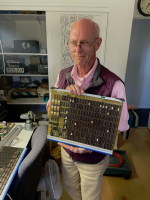- Apr 17, 2020
- 542
Thanks to the invention he helped create in the 1970s, people can send email over an office network or visit a website through a coffee shop hot spot.
David Boggs, an electrical engineer and computer scientist who helped create Ethernet, the computer networking technology that connects PCs to printers, other devices and the internet in offices and homes, died on Feb. 19 in Palo Alto, Calif. He was 71.
His wife, Marcia Bush, said his death, at Stanford Hospital, was caused by heart failure.
In the spring of 1973, just after enrolling as a graduate student at Stanford University, Mr. Boggs began an internship at Xerox PARC, a Silicon Valley research lab that was developing a new kind of personal computer. One afternoon, in the basement of the lab, he noticed another researcher tinkering with a long strand of cable.
The researcher, another new hire named Bob Metcalfe, was exploring ways of sending information to and from the lab’s new computer, the Alto. Mr. Metcalfe was trying to send electrical pulses down the cable, and he was struggling to make it work. So Mr. Boggs offered to help.
Over the next two years, they designed the first version of Ethernet.
“He was the perfect partner for me,” Mr. Metcalfe said in an interview. “I was more of a concept artist, and he was a build-the-hardware-in-the-back-room engineer.”
Many of the key technologies that would be developed over the next two decades as part of the Alto project would come to define the modern computer, including the mouse, the graphical user interface, the word processor and the laser printer, as well as Ethernet.
Ethernet was not the first networking technology. Most notably, researchers at various universities and companies were already running a computer network called Arpanet, which would evolve into today’s internet. But Ethernet was something different — a way of connecting devices in proximity, not over long distances.
Other universities and companies built similar technologies. But in the 1980s and ’90s, after Ethernet was codified into an industry standard, it became the dominant protocol for building networks in corporate offices. It would eventually be used in homes too, if in smaller ways. Today’s wireless networks borrow pieces from the Ethernet protocol and often connect to Ethernet hardware.
“Whatever you are reading this on — if you are not reading it on paper — you are probably using Ethernet,” Marc Weber, curator and director of the Internet History Program at the Computer History Museum in Mountain View, Calif., said in an interview.
David Reeves Boggs was born on June 17, 1950, in Washington, D.C., and spent parts of his early childhood in Kentucky, Kansas and other places across the country. His father, James Boggs, was a finance officer in the U.S. Army whose job required him to move with his family to a new post every few years.
After his parents divorced, David Boggs grew up in Washington with his mother, Jane (McCallum) Boggs, and his older brother, Walter. The three of them lived in his grandmother’s house, near American University, where his mother went to work as an administrator, eventually overseeing admissions for the university’s law school.
After saving up for a radio operator’s license, David began building ham radios, spending his nights chatting with other operators across the country. His brother remembered the two of them stringing antennas from a second-floor bedroom to the roof over the garage.
“Back then, those wires seemed so long,” said Walter Boggs, who still lives in the house. “Now it looks like a very short distance.”
David Boggs earned his bachelor’s degree in electrical engineering at Princeton University before starting at Stanford, where he eventually received both a master’s and a Ph.D., also in electrical engineering. Early in his Stanford career, he saw a presentation from Alan Kay, one of the key thinkers at PARC. He introduced himself to Mr. Kay, which led to an internship at the lab and later a full-time research position.
At PARC, as Mr. Metcalfe and Mr. Boggs pieced together a blueprint for Ethernet technology, borrowing ideas from a wireless network at the University of Hawaii called ALOHAnet. This work dovetailed with one of Mr. Boggs’s oldest interests: radio.
Sending tiny packets of information between computers and other devices, including printers, Ethernet could potentially work both with wires and without. In the 1980s, it became the standard protocol for wireline PC networks. In the late ’90s, it served as the basis for Wi-Fi, which would pervade homes and offices over the next two decades.
However it was used, the power of Ethernet was that it assumed things would go wrong. Even if some packets were lost — as they inevitably would be — the network could keep going.
In 1979, Mr. Metcalfe founded a company, 3Com, that commercialized Ethernet, while Mr. Boggs chose to remain at PARC as a researcher. Later, he moved to another research lab at DEC, one of the computing giants of the 1970s and ’80s, before starting his own Ethernet company, LAN Media, which was later sold to a larger player called SBE.
Mr. Boggs’s wife and brother are his only immediate survivors.
Before becoming the dominant networking protocol, Ethernet was challenged by several other technologies. In the early 1980s, Mr. Metcalfe said, when Mr. Boggs took the stage at a California computing conference, at the San Jose Convention Center, to discuss the future of networking, a rival technologist questioned the mathematical theory behind Ethernet, telling Mr. Boggs that it would never work with large numbers of machines.
His response was unequivocal. “Seems Ethernet does not work in theory,” he said, “only in practice.”
Last edited by a moderator:


